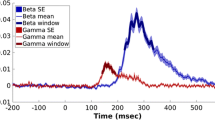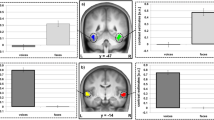Abstract
People diagnosed with autism spectrum disorder (ASD) characteristically present with severe difficulties in interpreting every-day social signals. Currently it is assumed that these difficulties might have neurobiological correlates in alterations in activation as well as in connectivity in and between regions of the social perception network suggested to govern the processing of social cues. In this study, we conducted functional magnetic resonance imaging (fMRI)-based activation and connectivity analyses focusing on face-, voice-, and audiovisual-processing brain regions as the most important subareas of the social perception network. Results revealed alterations in connectivity among regions involved in the processing of social stimuli in ASD subjects compared to typically developed (TD) controls—specifically, a reduced connectivity between the left temporal voice area (TVA) and the superior and medial frontal gyrus. Alterations in connectivity, moreover, were correlated with the severity of autistic traits: correlation analysis indicated that the connectivity between the left TVA and the limbic lobe, anterior cingulate and the medial frontal gyrus as well as between the right TVA and the frontal lobe, anterior cingulate, limbic lobe and the caudate decreased with increasing symptom severity. As these frontal regions are understood to play an important role in interpreting and mentalizing social signals, the observed underconnectivity might be construed as playing a role in social impairments in ASD.



Similar content being viewed by others
References
American Psychiatric Association (2013) Diagnostic and statistical manual of mental disorders (5th ed.). Arlington, VA: American Psychiatric Publishing
Amodio DM, Frith CD (2006) Meeting of minds: the medial frontal cortex and social cognition. Nat Rev Neurosci 7(4):268–277
Ashwin C, Baron-Cohen S, Wheelwright S, O’Riordan M, Bullmore ET (2007) Differential activation of the amygdala and the ‘social brain’ during fearful face-processing in Asperger syndrome. Neuropsychologia 45(1):2–14
Baron-Cohen S, Wheelwright S (2004) The empathy quotient: an investigation of adults with Asperger syndrome or high functioning autism, and normal sex differences. J Autism Dev Disord 34(2):163–175
Baron-Cohen S, Ring HA, Wheelwright S, Bullmore ET, Brammer MJ, Simmons A et al (1999) Social intelligence in the normal and autistic brain: an fMRI study. Eur J Neurosci 11(6):1891–1898
Baron-Cohen S, Wheelwright S, Skinner R, Martin J, Clubley E (2001) The autism-spectrum quotient (AQ): evidence from Asperger syndrome/high-functioning autism, males and females, scientists and mathematicians. J Autism Dev Disord 31(1):5–17
Baron-Cohen S, Richler J, Bisarya D, Gurunathan N, Wheelwright S (2003) The systemizing quotient: an investigation of adults with Asperger syndrome or high-functioning autism, and normal sex differences. Philos Trans R Soc Lond B Biol Sci 358(1430):361–374
Belin P, Zatorre RJ, Lafaille P, Ahad P, Pike B (2000) Voice-selective areas in human auditory cortex. Nature 403(6767):309–312
Belmonte MK, Allen G, Beckel-Mitchener A, Boulanger LM, Carper RA, Webb SJ (2004) Autism and abnormal development of brain connectivity. J Neurosci: Off J Soc Neurosci 24(42):9228–9231
Bölte S, Crecelius K, Poustka F (2000) The questionnaire on behaviour and social communication: an autism screening instrument for research and practice [in German]. Diagnostica 46:149–155
Bruck C, Kreifelts B, Wildgruber D (2011) Emotional voices in context: a neurobiological model of multimodal affective information processing. Phys Life Rev 8(4):383–403
Castelli F, Frith C, Happe F, Frith U (2002) Autism, Asperger syndrome and brain mechanisms for the attribution of mental states to animated shapes. Brain: J Neurol 125(Pt 8):1839–1849
Constantino JN (2013) Social responsiveness scale. In: Volkmar F (ed) Encyclopedia of autism spectrum disorders. Springer, New York, pp 2919–2929
Courchesne E, Pierce K (2005) Why the frontal cortex in autism might be talking only to itself: local over-connectivity but long-distance disconnection. Curr Opin Neurobiol 15(2):225–230
Critchley HD, Daly EM, Bullmore ET, Williams SC, Van Amelsvoort T, Robertson DM et al (2000) The functional neuroanatomy of social behaviour: changes in cerebral blood flow when people with autistic disorder process facial expressions. Brain: J Neurol 123(Pt 11):2203–2212
Dalton KM, Nacewicz BM, Johnstone T, Schaefer HS, Gernsbacher MA, Goldsmith HH et al (2005) Gaze fixation and the neural circuitry of face processing in autism. Nat Neurosci 8(4):519–526
Eigsti IM, Schuh J, Mencl E, Schultz RT, Paul R (2012) The neural underpinnings of prosody in autism. Child Neuropsychol: J Norm Abnorm Dev Child Adolesc 18(6):600–617
Epstein R, Harris A, Stanley D, Kanwisher N (1999) The parahippocampal place area: recognition, navigation, or encoding? Neuron 23(1):115–125
Ethofer T, Bretscher J, Gschwind M, Kreifelts B, Wildgruber D, Vuilleumier P (2012) Emotional voice areas: anatomic location, functional properties, and structural connections revealed by combined fMRI/DTI. Cereb Cortex 22(1):191–200
First, MB, Spitzer, RL, Gibbon M, Williams, JBW (1996) Structured Clinical Interview for DSM-IV Axis I Disorders, Clinician Version (SCID-CV). Washington, D.C.: American Psychiatric Press, Inc. (trans: Wittchen H-U, Wunderlich U, Gruschwitz S, Zaudig M (1997)
Friston KJ, Glaser DE, Henson RN, Kiebel S, Phillips C, Ashburner J (2002) Classical and Bayesian inference in neuroimaging: applications. NeuroImage 16(2):484–512
Gast Ursula, Rodewald Frauke, Kersting Anette, Emrich Hinderk M (2001) Diagnostik und Therapie Dissoziativer (Identitäts-) Störungen. Psychotherapeut 46(5):289–300
Gervais H, Belin P, Boddaert N, Leboyer M, Coez A, Sfaello I et al (2004) Abnormal cortical voice processing in autism. Nat Neurosci 7(8):801–802
Hadjikhani N, Joseph RM, Snyder J, Chabris CF, Clark J, Steele S et al (2004) Activation of the fusiform gyrus when individuals with autism spectrum disorder view faces. NeuroImage 22(3):1141–1150
Hahamy A, Behrmann M, Malach R (2015) The idiosyncratic brain: distortion of spontaneous connectivity patterns in autism spectrum disorder. Nat Neurosci 18(2):302–309
Haxby JV, Ungerleider LG, Horwitz B, Maisog JM, Rapoport SI, Grady CL (1996) Face encoding and recognition in the human brain. Proc Natl Acad Sci USA 93(2):922–927
Haxby JV, Hoffman EA, Gobbini MI (2002) Human neural systems for face recognition and social communication. Biol Psychiatry 51(1):59–67
Hubl D, Bolte S, Feineis-Matthews S, Lanfermann H, Federspiel A, Strik W et al (2003) Functional imbalance of visual pathways indicates alternative face processing strategies in autism. Neurology 61(9):1232–1237
Kamp-Becker I, Mattejat F, Wolf-Ostermann K, Remschmidt H (2005) The Marburg Rating Scale for Asperger’s Syndrome (MBAS)—a screening instrument for high-functioning autistic disorders. Zeitschrift für Kinder- und Jugendpsychiatrie und Psychotherapie 33(1):15–26
Kanwisher N, McDermott J, Chun MM (1997) The fusiform face area: a module in human extrastriate cortex specialized for face perception. J Neurosci: Off J Soc Neurosci 17(11):4302–4311
Kreifelts B, Ethofer T, Grodd W, Erb M, Wildgruber D (2007) Audiovisual integration of emotional signals in voice and face: an event-related fMRI study. NeuroImage 37(4):1445–1456
Kreifelts B, Ethofer T, Huberle E, Grodd W, Wildgruber D (2010) Association of trait emotional intelligence and individual fMRI-activation patterns during the perception of social signals from voice and face. Hum Brain Mapp 31(7):979–991
Lee PS, Yerys BE, Della Rosa A, Foss-Feig J, Barnes KA, James JD et al (2009) Functional connectivity of the inferior frontal cortex changes with age in children with autism spectrum disorders: a fcMRI study of response inhibition. Cereb Cortex 19(8):1787–1794
Maximo JO, Keown CL, Nair A, Muller RA (2013) Approaches to local connectivity in autism using resting state functional connectivity MRI. Front Hum Neurosci 7:605
Maximo JO, Cadena EJ, Kana RK (2014) The implications of brain connectivity in the neuropsychology of autism. Neuropsychol Rev 24(1):16–31
Minshew NJ, Keller TA (2010) The nature of brain dysfunction in autism: functional brain imaging studies. Curr Opin Neurol 23(2):124–130
Nichols T (2010) Corrected cluster size threshold. Neuroimaging Statistics Tips & Tools, University of Warwick. http://blogs.warwick.ac.uk/nichols/entry/spm5_gem_6/trackback/. Accessed 20 Jan 2016
Nichols T, Brett M, Andersson J, Wager T, Poline JB (2005) Valid conjunction inference with the minimum statistic. Neuroimage 25(3):653–660
Oldfield RC (1971) The assessment and analysis of handedness: the Edinburgh inventory. Neuropsychologia 9(1):97–113
Pierce K, Muller RA, Ambrose J, Allen G, Courchesne E (2001) Face processing occurs outside the fusiform ‘face area’ in autism: evidence from functional MRI. Brain: J Neurol 124(Pt 10):2059–2073
Sato W, Toichi M, Uono S, Kochiyama T (2012) Impaired social brain network for processing dynamic facial expressions in autism spectrum disorders. BMC Neurosci 13:99
Schelinski S, Borowiak K, von Kriegstein K (2014) Neural processing of voices in autism spectrum disorder. Paper presented at the 20th annual meeting of the Organization for Human Brain Mapping (OHBM), Hamburg, Germany
Schultz RT, Grelotti DJ, Klin A, Kleinman J, Van der Gaag C, Marois R et al (2003) The role of the fusiform face area in social cognition: implications for the pathobiology of autism. Philos Trans R Soc Lond B Biol Sci 358(1430):415–427
Uddin LQ, Supekar KS, Ryali S, Menon V (2011) Dynamic reconfiguration of structural and functional connectivity across core neurocognitive brain networks with development. J Neurosci 31(50):18578–18589
Wang AT, Lee SS, Sigman M, Dapretto M (2006) Neural basis of irony comprehension in children with autism: the role of prosody and context. Brain: J Neurol 129(Pt 4):932–943
Watanabe T, Yahata N, Abe O, Kuwabara H, Inoue H, Takano Y et al (2012) Diminished medial prefrontal activity behind autistic social judgments of incongruent information. PLoS One 7(6):e39561
Welchew DE, Ashwin C, Berkouk K, Salvador R, Suckling J, Baron-Cohen S et al (2005) Functional disconnectivity of the medial temporal lobe in Asperger’s syndrome. Biol Psychiatry 57(9):991–998
Wicker B, Fonlupt P, Hubert B, Tardif C, Gepner B, Deruelle C (2008) Abnormal cerebral effective connectivity during explicit emotional processing in adults with autism spectrum disorder. Soc Cogn Affect Neurosci 3(2):135–143
Wildgruber D, Ethofer T, Grandjean D, Kreifelts B (2009) A cerebral network model of speech prosody comprehension. Int J Speech-Lang Pathol 11:277–281
World Health Organization (1992) The ICD-10 classification of mental and behavioural disorders: Clinical descriptions and diagnostic guidelines. Geneva: World Health Organization
Acknowledgments
E. Hoffmann and C. Brück contributed equally to the work. E. Hoffmann recorded fMRI and behavioral data, performed data analysis and assessment of the results, designed graphics and tables, and wrote the manuscript. C. Brück designed the study, wrote the ethic statement, recorded fMRI and behavioral data, gave advice regarding the data analysis and revised the manuscript. B. Kreifelts helped with the study design, provided the stimulus material for the AV integration experiment, recorded fMRI data, advised the programming of analysis scripts and gave valuable input for the manuscript. T. Ethofer recorded fMRI data and gave advice on the manuscript. D. Wildgruber was senior author of the study, which he co-designed. He also assessed and discussed results, and gave advice on the manuscript. We would like to thank the Department for Biomedical Magnetic Resonance, University Hospital Tübingen, for providing the Trio 3 T scanner, which we used in our study. The study was not funded by a grant but by means of the hospital.
Author information
Authors and Affiliations
Corresponding author
Ethics declarations
Conflict of interest
The authors declare no conflict of interest.
Additional information
E. Hoffmann and C. Brück contributed equally to the work and share first authorship.
Electronic supplementary material
Below is the link to the electronic supplementary material.
Rights and permissions
About this article
Cite this article
Hoffmann, E., Brück, C., Kreifelts, B. et al. Reduced functional connectivity to the frontal cortex during processing of social cues in autism spectrum disorder. J Neural Transm 123, 937–947 (2016). https://doi.org/10.1007/s00702-016-1544-3
Received:
Accepted:
Published:
Issue Date:
DOI: https://doi.org/10.1007/s00702-016-1544-3




